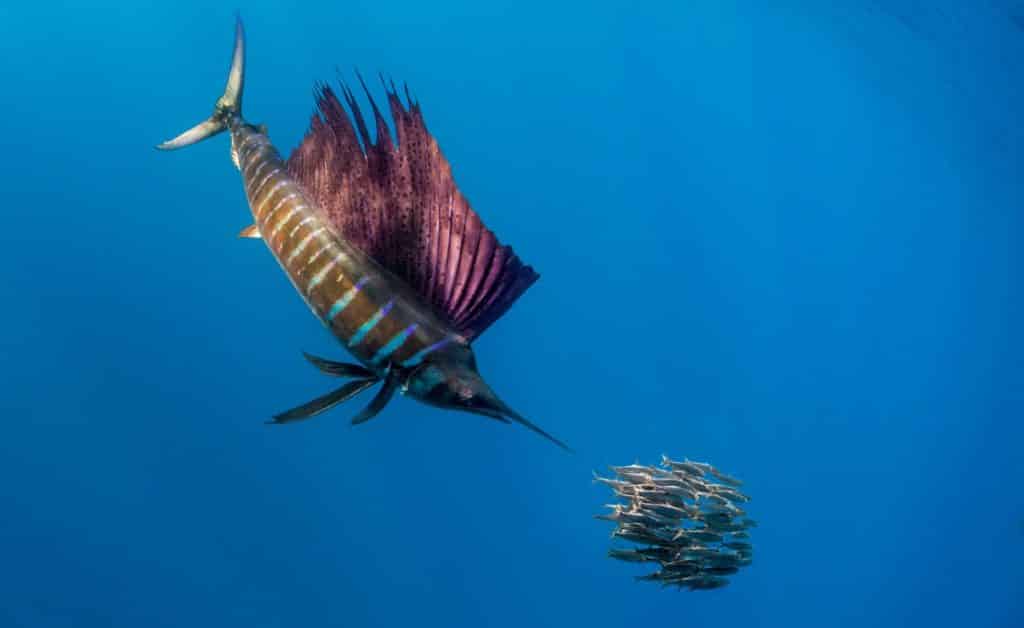Contact us if your target is Sailfish in Costa Rica
See our Sailfish Photo Gallery

Sailfish
Sailfish (Istiophorus platypterus) is a species of billfish found in tropical and subtropical waters around the world. They are known for their long, slender bodies and large dorsal fins that resemble sails, which is where they get their name.
Sailfish can grow up to 11 feet long and weigh up to 220 pounds. They are a highly migratory species, traveling thousands of miles each year in search of food. They are also known for their speed and agility, with some individuals able to swim at speeds of up to 68 miles per hour.
Sailfish are apex predators and feed on a variety of prey, including mackerel, tuna, squid, and crustaceans. They are considered a prized catch by sportfishers due to their impressive fighting abilities and acrobatic jumps.
Sailfish are also considered a delicacy in some cultures, and are often used for sashimi and sushi.
In terms of conservation, Sailfish are not considered endangered, but some populations have been affected by commercial fishing and habitat loss. In recent years, there have been efforts to establish sustainable management practices to ensure the long-term survival of the species.
In the Costa Rica North Pacific coast it can be found every month of the year, especially from May to August. In the Central Pacific coast the best season is from December to the end of April, October can be good too. In the Southern zone the best fishing season is from December to March. The maximum point is in August or September.
Known as the type of fish whose way of swimming is really spectacular. With its peculiar dorsal fin with enormous dimensions, this fish can swim at a great speed in search of its prey or to flee from its predators.
Sailfish characteristics
Sailfish is considered a species of the Atlantic Ocean and one of the most fabulous fish that we can find in the seas and oceans around the world. In Costa Rica is found largely on the Pacific, that one is a subspecies and is larger that the Atlantic one. Both families have bluish or gray colors and a white belly.
Another peculiarity of this fish is its snout. It has a somewhat odd shape, narrowing to a point. It resembles a sharp saber. When this fish is in action, it is impressive how it is able to swim at high speeds in search of its prey. Due to its morphology it can cut the water with extraordinary ease. Therefore, it can reach great speeds.
The first dorsal fin is the main element that makes it different from other fish, having between 37 and 49 rays. The second dorsal fin is smaller and only has 6 or 8 rays. The tail is a fundamental element that it uses to reach great speeds since it is joined by a strong and powerful caudal peduncle.
It has been registered Sailfish with 100 kilograms in weight. The most common is that they are around 50 kilograms.
Sailfish Habitat
This fish inhabits the upper waters of the oceans. He does not usually live in the depths and always opt for warmer and warmer waters. In the area where they are distributed they have great facility to find their prey. Thanks to the speed at which they move, their task of getting food is not very hard to say.
The Atlantic sailfish varies its range depending on the temperature of the water and in some cases the conditions of wind direction and force. At the ends of its range (both north and south) it appears only during the warmer months, since it prefers warmer waters. Changes in their habitat are mainly due to migration to other areas of their prey. Therefore, to continue feeding they must move.
They are usually found in the warmest and upper areas above the thermocline. When he has to migrate, he does so to the waters closest to the coasts. Its ideal temperature is between 21 and 29 degrees. On occasion, fish fry have been found in the Mediterranean Sea that have been lost during their migratory trips.
On the other hand, the Pacific sailfish is usually found in temperate and tropical waters of all the world’s oceans. Its distribution is tropical, but it can also be found in equatorial areas. This species is found along the coastal regions of the temperate latitudes, although they can also be found in the central areas of the oceans. They are epipelárgicas species. This means that they spend most of their adult lives in the upper zone of the thermocline.
Sailfish Behavior
This fish is totally carnivorous and is considered one of the most skilled predators of the oceans. It is undoubtedly the fastest of all warm and warm waters.
It usually feeds on squid, octopus, tuna and flying fish. You can use its beak to separate fish cells from the entire school and thus make them more vulnerable to capture. They are able to submerge up to 30 meters deep, but prefer to make it closer to the surface to help with sunlight. It is located near the coral edges to have a wider view of the terrain and to corner its prey.
Sailfish is a solitary species (hence its ease in continuous migration in search of prey). It is rare to see them in groups, although sometimes they can be seen forming small groups to facilitate hunting.
It is a species that organizes and first tests the ground before launching to hunt to avoid possible obstructions.
Males and females have the same behavior, surrounding prey and forcing the school to close ranks. The attacks are fast and accurate, each of them is preceded by a surprising deployment of the dorsal fin, which extends the profile of the hunter more than double.
Sailfish Reproduction
The reproduction of sailfish has various contradictions. The female spawns numerous times in the same year. The place they choose for spawning is usually an area where the temperature is about 26 degrees Celsius, that makes Costa Rica a perfect area for breeding. They usually do it around the coasts. For each laying made by the female lays more than one million eggs that are drifting. The male, once the eggs are thrown, immediately fertilizes the vast majority of the eggs.
From the eggs that manage to be fertilized, there are small offspring that keep floating on the surface, becoming an easy prey for predators. Therefore, of the million eggs that the female throws, only a few survive to grow and become adults.
The young of fry have an extremely rapid development so, if they manage to survive the first stage where they are fresh meat for predators, they can reach their adult stage. Its fins are fully developed when they reach five centimeters in length.
The most frequent spawning months are between March and October. When fish are adults, their most common enemies are larger fish such as sharks.
About Sailfish Fishing
Sailfish is a species of marine fish found in tropical and subtropical waters around the world. Sailfish are known for their distinctive dorsal fin, which is elongated and has a sail-like appearance, giving the fish its name. They are also known for their strong fighting ability and their acrobatic jumps when hooked.
Sailfish fishing typically takes place in the open ocean and can be done from both large commercial fishing vessels and smaller private boats. Anglers typically use specialized equipment, such as heavy-duty fishing rods and reels, to handle the strength and size of sailfish. Baits and lures, such as live baitfish, dead baitfish, and artificial lures, are used to attract the fish.
Sailfish can be caught using various fishing techniques, such as trolling, casting, and live baiting. Trolling is the most common method, using various lures and baits to cover a larger area of the sea. Live baiting is also a popular technique, where live baitfish are used to attract the sailfish.
Sailfish are considered a prized catch for sport fishermen, due to their strong fighting ability and acrobatic jumps. They are also considered a delicacy in some countries and are used for food in local communities.
Sailfish populations are considered stable in many regions, but overfishing and unsustainable fishing practices have led to declines in some areas. Therefore, conservation efforts have been implemented in some regions to protect these fish and ensure their populations remain sustainable.
It is also important to note that Sailfish fishing can be physically demanding, as they are strong fighters and can put up a long and hard battle once hooked. They are also known for their spectacular jumps, which can make for an exciting fishing experience. International Game Fish Association (IGFA) has specific rules and regulations for anglers to follow while catching sailfish and other big game fishes.



